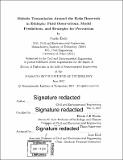| dc.contributor.advisor | Elfatih A.B. Eltahir. | en_US |
| dc.contributor.author | Endo, Noriko Ph. D. Massachusetts Institute of Technology | en_US |
| dc.contributor.other | Massachusetts Institute of Technology. Department of Civil and Environmental Engineering. | en_US |
| dc.coverage.spatial | f-et--- | en_US |
| dc.date.accessioned | 2017-09-15T15:33:58Z | |
| dc.date.available | 2017-09-15T15:33:58Z | |
| dc.date.copyright | 2017 | en_US |
| dc.date.issued | 2017 | en_US |
| dc.identifier.uri | http://hdl.handle.net/1721.1/111433 | |
| dc.description | Thesis: Ph. D. in Environmental Engineering, Massachusetts Institute of Technology, Department of Civil and Environmental Engineering, 2017. | en_US |
| dc.description | Cataloged from PDF version of thesis. | en_US |
| dc.description | Includes bibliographical references (pages 263-278). | en_US |
| dc.description.abstract | New dam construction is likely to exacerbate malaria transmission in Africa. The vectors of malaria - Anopheles mosquitoes - use bodies of water as breeding sites. Thus, dams and their reservoirs are associated with elevated risks of malaria. In Africa, more than 150 dams are currently under construction or proposed, and most of them are designed without satisfactory considerations for the potential of enhancing malaria transmission. Precise environmental mechanisms of malaria transmission around reservoirs are yet to be identified. Understanding of these mechanisms should lead to a better assessment of the impacts of dam construction. Moreover, incorporation of such understanding into environmental management approaches can sustainably and cost-effectively prevent malaria transmission. This thesis first develops a malaria transmission model around a typical reservoir in Africa based on extensive multi-year field surveys around the Koka Reservoir in Ethiopia. A mechanistic malaria transmission model, HYDREMATS (Hydrology, Entomology, and Malaria Transmission Simulator), was extended to simulate the hydrology influenced by a reservoir system and to represent the associated behaviors of Anopheles mosquitoes in such environment. The model was calibrated and tested against various observational data on hydrology around the reservoir, and entomology of Anopheles mosquitoes. Three distinct environmental mechanisms of malaria transmission around water resource reservoirs were identified: faster parasite development during warmer seasons; amplification of reproductive activities at closer shoreline-to-house distances; enhancement of Anopheles populations under favorable wind conditions. The effect of temperature and the associated impact of global warming over the Ethiopian Highlands were analyzed. This region is particularly susceptible to the future risk of malaria transmission, because of the high sensitivity to warming and also the ephemeral immunity of the inhabitants. Specific areas expected to have high malaria risk towards the end of the 21st century were identified, including 12% of the land area and a third of the population in Ethiopia. House-to-reservoir distance and the wind direction were identified as important factors in the design of malaria-resistant villages. Keeping houses further away than certain critical distances from the shoreline was demonstrated to decrease malaria transmission. Beyond these critical distances, malaria transmission can no longer be sustained. If houses cannot not be built further away than the critical distances for malaria transmission, then extra control measures should be targeted towards such houses. The critical distances to prevent malaria are defined based on environmental and biological conditions. Malaria can also be mitigated if a village location is planned carefully. In order to effectively mitigate malaria, a village should not be located upwind of a reservoir, in general, because such location will have favorable breeding conditions with small waves and enhanced host-seeking activities through CO₂ attraction from human settlements upwind. Given seasonality of wind directions and other weather conditions, wind direction during periods of high temperature, low wind speed, and low reservoir water levels are critical in deciding where to locate villages around new reservoirs. By shedding light on the precise environmental mechanisms of malaria transmission around reservoirs, the findings in this thesis are presented to inform environmental policy on how to prevent enhancement of malaria transmission around dams and reservoirs. | en_US |
| dc.description.statementofresponsibility | by Noriko Endo. | en_US |
| dc.format.extent | 278 pages | en_US |
| dc.language.iso | eng | en_US |
| dc.publisher | Massachusetts Institute of Technology | en_US |
| dc.rights | MIT theses are protected by copyright. They may be viewed, downloaded, or printed from this source but further reproduction or distribution in any format is prohibited without written permission. | en_US |
| dc.rights.uri | http://dspace.mit.edu/handle/1721.1/7582 | en_US |
| dc.subject | Civil and Environmental Engineering. | en_US |
| dc.title | Malaria transmission around the Koka Reservoir in Ethiopia : field observations, model predictions, and strategies for prevention | en_US |
| dc.title.alternative | HYDREMATS | en_US |
| dc.type | Thesis | en_US |
| dc.description.degree | Ph. D. in Environmental Engineering | en_US |
| dc.contributor.department | Massachusetts Institute of Technology. Department of Civil and Environmental Engineering | |
| dc.identifier.oclc | 1003292628 | en_US |
